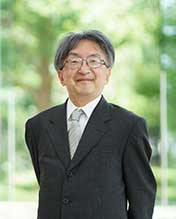Greetings from the Director
What wisdom is required for us to survive?
It was 1991. The Ministry of Education, Science, Sports and Culture (the organization that would later become MEXT) completed a massive overhaul that rolled back regulations on what universities taught. It was called the “Revision of Standards for the Establishment of Universities.” University students must earn 124 credits to graduate with a bachelor’s degree. This was true then and remains true now. However, before the revisions, the makeup of those 124 credits was rigidly defined. In order to graduate, students needed 124 credits. 36 credits were to be earned from general education courses, 8 credits from foreign language courses, 4 credits from physical education courses, and 76 credits from courses related to a student’s major. Personally, as someone who went through university before the rollback and loathed exercising, it took a lot of perseverance to earn the PE credits needed to graduate.
However, to get back to the subject at hand, the provision stipulating which credits needed to be earned was removed in 1991. Essentially, this meant that universities could choose their own ways of breaking down the 124 credits. If you asked me, I would wager that, at the time, the Ministry of Education thought that shifting the emphasis from the “liberal arts” to more specialized curriculum would be beneficial to future generations. This was the same year that the Soviet Union collapsed, two years after the fall of the Berlin Wall. It goes without saying that the world was truly on the verge of massive change. And with it, there was a certainty that all academic fields would become more sophisticated and specialized. After all, that was the main point of a university education. The “liberal arts” would have to take a back seat. In 1991, this vision was shared not only by the Ministry of Education but was prevalent throughout the world.
But did these predictions come true? The meaning of the Japanese word “kyōyō (education)" varies and can be difficult to nail down, the more complex it seems. One constant, however, is its connection to the English term "liberal arts.” When translated with extra context, the liberal arts imply “the skills required to freely navigate the world on one’s own while committing few errors in judgment.” While some might say that’s just describing “common sense,” a closer look at the truth of the matter reveals a more complicated picture. The end of the Cold War led to more political variables, more economic variables as capitalism expanded, more social and cultural variables as values became more diverse, and faster scientific developments to the point where it became impossible for ordinary people to keep up with everything. No amount of study could educate people enough to comfortably navigate the world in the 21st century. Perhaps that’s an overstatement.
“It is a thousand times better to have common sense without education than to have education without common sense” It’s a phrase you’ve likely heard before. However, developing common sense is easier said than done in our society. This is where universities must improve! I have heard one Japanese sociologist argue that all four years of undergraduate education should be dedicated to studying the liberal arts, leaving more specialized education for graduate school. While that may be a tad extreme, I believe there is merit to recognizing the importance of expanding liberal arts education and contextualizing it within the modern world. Keio, at the very dawn of the 21st century, established its Research Center for the Liberal Arts in 2002. This was, if I may overstate my case, both historically inevitable and a revelatory manifestation of our age. We will continue to do our utmost to investigate and explore what forms of wisdom are needed to navigate our lives today and survive long into the future. We hope that you will join us in this journey.

Director of Keio Research Center for the Liberal Arts
Katayama, Morihide

